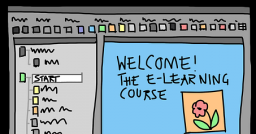
Does your online course need a menu?

The menu can help students navigate within the contents in an easy and intuitive way. Is it always necessary to use this element? What are the cases in which it is preferable to insert a menu in an online course?
When designing an online course, there are many elements that the programming team must take into consideration. One of these is the menu. Those involved in e-learning or those who have already followed an online training course will have seen a section, usually on the left side of the screen, that gives the opportunity to navigate within the course, allowing, for example, to view the list of training modules.
The menu, therefore, can be an important element for the students, since it allows to have a clearer and more complete view of the training path provided by the course and to move from one content to another. In some cases, moreover, it is possible to hide this section, in order to have a clearer view of the contents. This element can be a help both for the students and for the design team that, in this way, can reach a greater level of usability of the platform.
Naturally, the need to insert or not the menu will depend on the type of course.
What to consider before inserting a menu in the online course?
The first question to ask is: is the course very dense? There are rather short online training courses (such as, for example, micro-learning) in which the menu is not a necessary element as the contents to be navigated will not be very branched and extended. If instead the course consists of a long list of lessons and topics, almost certainly a menu will help to make the course more orderly and easier to enjoy.
The menu is an element that can be useful especially if we have designed an "open" course. These are training courses that give the opportunity to the students to navigate freely between the lessons, without following a specific order and leaving everyone the freedom to access the final lessons even after the course has started.
In other cases, however, the course is designed in a more structured manner. This means that students can progress in education only by completing the previous lessons. In this case, the menu can be designed in such a way that part of the content is blocked or, simply, it may not be present, depending on the needs of the design team and, above all, of the course.
The moment you choose to insert the menu in the platform, you can choose from a wide range of models and different styles. As always, in addition to creativity and aesthetics, the menu must be designed in a clear and intuitive manner precisely because it is an element that serves to simplify the study of the students.
Did you like this article? Sign up for the newsletter and receive weekly news!
Subscribe to NewsletterComments:
No comments are in yet. You be the first to comment on this article!